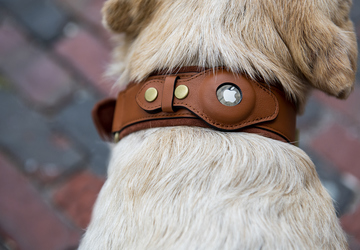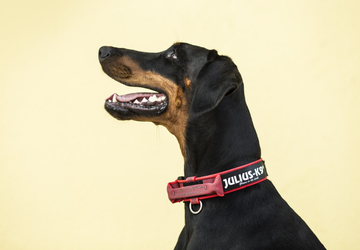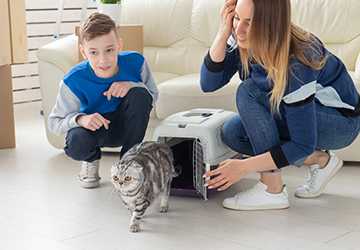For many pet owners, when to replace your pet's collar is a mystery. Collars are essential for safety and identification, but they have limited durability. Over time, wear and tear can reduce their effectiveness and comfort. Knowing when to replace your pet's collar can help ensure your pet stays safe and relaxed.
Signs of Worn Pet Collars
Noticeably, wear and tear are among the most important indicators of when your pet's collar should be replaced. Here are some symptoms you may recognize:
- Wear or tear: If you notice wear or tear on the edges, it's a clear sign that your pet's collar needs to be replaced.
- Fading: Fading in the collar may weaken the material.
Stretching: A stretched collar may no longer fit properly.
- Damaged buckle or clasp: Check the buckle or clasp for damage, as they are essential to the collar's safety.
- Rusted or damaged metal parts: If the metal parts of the collar are oxidized or damaged, it's time to replace it with a new one.
Health-Related Indicators

Sometimes, the signs of wear on your pet's collar are physical. Here are some health indicators to watch for:
- Skin irritation: If your pet's collar is irritated or inflamed, it could be due to a damaged or ill-fitting collar.
- Hair loss: Hair loss or thinning hair around the neck could indicate a collar that is too tight or worn.
- Allergic reactions: If your pet is experiencing allergic reactions, it could be due to an outdated collar material.
Tips for Choosing a New Pet Collar
Once you notice signs of wear on your pet's collar, the next step is to choose a new one.
Material Considerations
If you are considering buying a new pet collar, consider the material carefully. Many different materials offer a variety of different benefits:
- Nylon: Tough and lightweight, perfect for everyday use.
- Leather: Strong and durable, but can be heavy and require more care.
- Neoprene: Soft and comfortable, perfect for pets with sensitive skin.
Careful Calibration
A perfectly cut collar is essential for the comfort and safety of your valued companion. When choosing a new pet collar, be sure to carefully calibrate it by following these steps:
- Quantify the neck circumference: Use a soft measuring tape to accurately quantify your pet's neck circumference.
- Two-part finger rule: There must be room for two fingers between the collar and your pet's neck area.
Collars: Choose collars that are adjustable in size to accommodate physiological growth or weight fluctuations.
Safety Features
When choosing a new pet collar, consider safety features that can help you stay safe:
- Breakpoint collars: These collars are designed to release under pressure, preventing choking if the collar gets caught on something.
- Reflective materials: Reflective collars can increase visibility for pets that go out at night.
- ID tags and microchips: Make sure there is a safe place to place an ID tag and consider implanting a microchip in your pet for added security.
Pet Collar Care Strategies
Ongoing care is essential to extend the life of your pet's collar and ensure its continued safety and comfort. Here are some strategies for protection:
- Regular cleaning: Depending on the material, collars should be cleaned regularly to remove accumulated dirt and microbial contaminants.
- Carefully inspect for wear: Inspect frequently to identify signs of wear, such as fraying, stretching, or interference with the closure mechanism.
- Regular Adjustments: Ensure the collar fits optimally as your pet ages or fluctuates in weight.
When to Replace Your Pet's Collar: Frequency
The time it takes to replace your pet's collar depends on several factors, including the collar's material and your pet's activity level. Generally, it's recommended to check the collar every few months and replace it at least once a year or more frequently if you notice signs of wear on your pet's collar.
Types of Pet Collars and Their Benefits

Each type offers unique benefits and serves different purposes.
Flat Collars
Flat collars are the typical type of collar that is suitable for everyday activities. They are usually made of nylon or leather.
- Versatility: They accommodate a wide range of pets and countless activities.
- Variety: Available in various colours, patterns, and configurations.
- Ease of Use: Easy to put on and take off.
Martingale Collars
Martingale collars are designed for dogs who break away from traditional collars. They provide a harmonious balance between comfort and control.
- Safety: Reduces the risk of your dog escaping capture.
- Control: This can be easily corrected without choking hazards.
Adjustability: Adjustable to ensure a secure and comfortable fit.
Harnesses
Harnesses can be an alternative to traditional collars, improving control and reducing stress on your pet's cervical spine.
Support: Distributes pressure evenly across the chest and shoulder blades.
- Control: Great for training and walking pets that tend to pull.
- Comfort: Reduces the likelihood of injuries to the neck and tracheal area.
Head Halters
Also known as halters, head halters are designed to give owners greater control over their pet's head and direction.
- Control: Allows for maximum control over the pet's movements.
- Training: Very effective for training those pets that tend to pull.
- Safety: Minimizes the risk of cervical spine injuries.
Advanced Features of Modern Pet Collars
When choosing a new pet collar, consider advanced features that can improve safety and functionality.
GPS Tracking Collars
Geospatial Positioning System tracking collars are equipped with advanced technological equipment that allows owners to carefully monitor the precise location of their domestic companions within the same time frame.
- Safety: Constantly aware of your pet's whereabouts, giving you peace of mind.
- Technology: Often accompanied by a mobile app for easy tracking.
- Durability: Designed to withstand different weather conditions and intense activities.
Smart Collars
Smart collars offer many features, from activity monitoring to comprehensive health monitoring.
- Health Monitoring: Accurately monitor vital signs and activity indicators.
- Alerts: Send notifications of health anomalies or unusual activity to the owner's smartphone.
- Convenience: Often integrates features like temperature warnings and virtual boundaries.
Reflective and LED Collars
Reflective and LED collars are designed to improve visibility at dusk.
- Visibility: Improve safety when out and about at night.
- Durability: Made of durable materials to withstand regular use.
- Adjustability: Available in various sizes and designs to accommodate different pets.
Conclusion
Knowing when to replace your pet's collar is essential to ensuring your pet's safety and comfort. Regularly checking your pet's collar for signs of wear and carefully choosing a new one can ensure your furry companion stays happy and healthy. Always prioritise your pet's health by choosing the right material, ensuring a good fit, and considering safety features. With these tips, you can keep your pet safe and comfortable with a collar that meets your pet's needs.

















